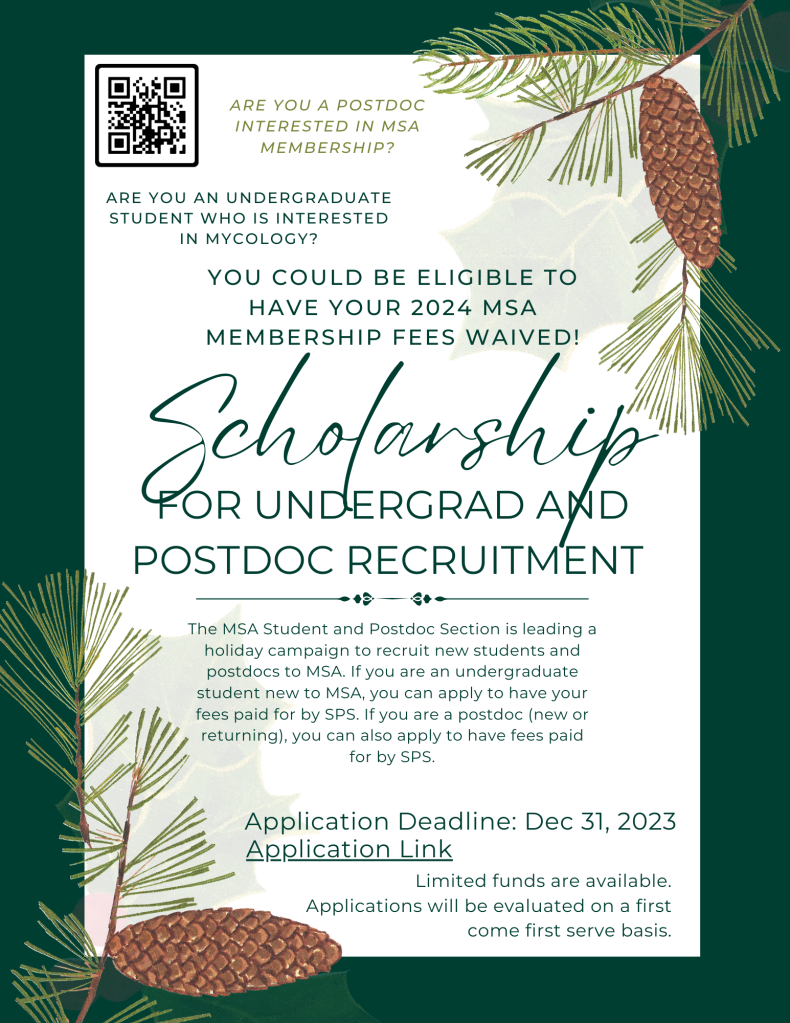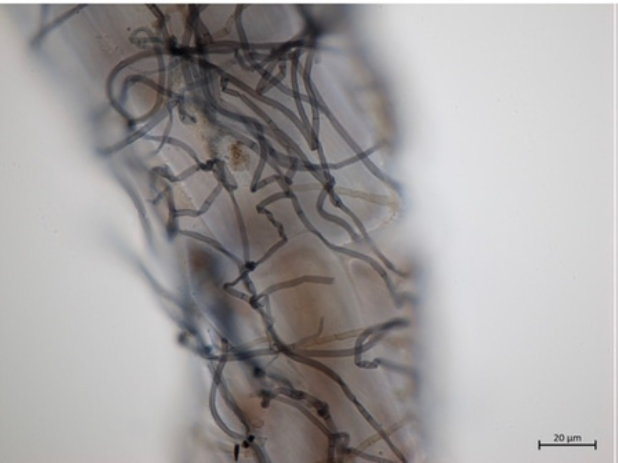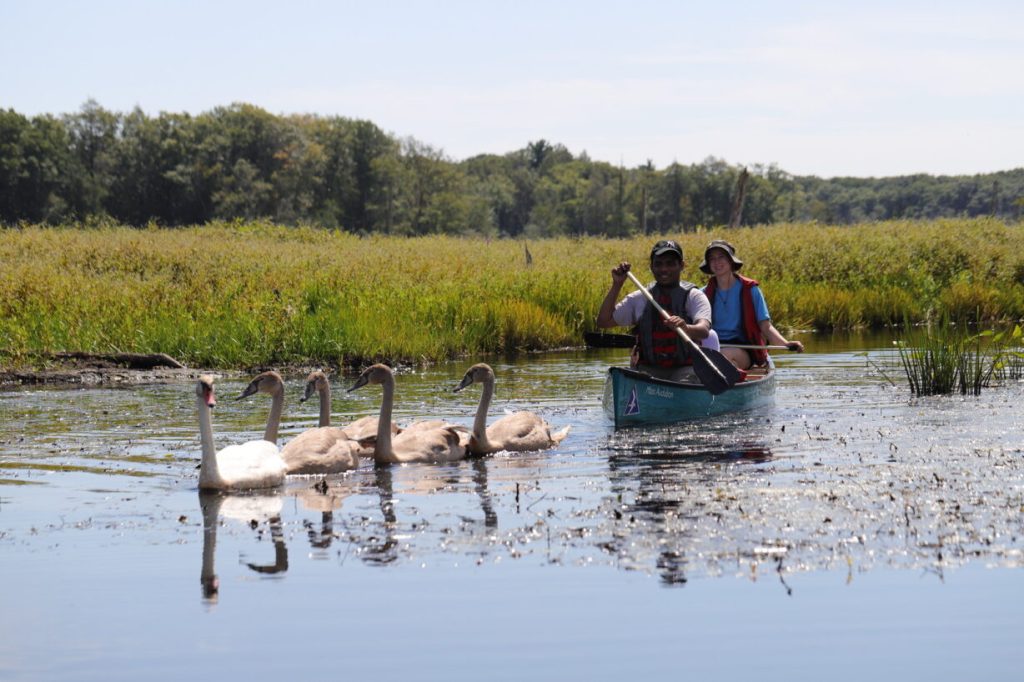Are you a postdoc in MSA? Let’s connect! Tell us about yourself! Click below to complete the 2024 Postdoc survey:








Where did you grow up?
West Virginia
Who is your advisor?
Dr. Teresa Pawlowska
Tell us about your project!
I work on fungal immune responses to antagonistic bacteria, using Rhizopus microsporus and Mycetohabitans spp. as a model.
I’m currently using florescence microscopy and flow cytometry to quantify the role of cell wall remodeling in the fungal innate immune response. The mechanism of immunity, particularly in early divergent fungi, is not well understood, but my preliminary work suggests that the cell wall plays an important role.
What is your favorite fungus and why?
Massospora cicadina, the lifestyle is fascinating and super weird!
Who is your mycology role model?
My undergraduate PI, Matt Kasson, who went out of his way to create a supportive and nurturing lab where students were able to be themselves.
What do you do outside of research?
Outside of research, I work as a DEI educator through the Cornell chapter of Project Biodiversify. We focus on promoting inclusive practices in STEM research and education. I highly recommend checking out the national organization or a local chapter!

In this Issue:
2 – General announcements
3 – Undergrad/Postdoc Membership Scholarships (Due 12/31)
4 – 2024 SPS Digital Art Contest
5 – Student Spotlight: Hana Barrett
6 – SPS Gift Ideas!
7 – MSA SPS resources


Are you an undergraduate student who is interested in mycology? Are you a postdoc interested in MSA membership? You could be eligible to have your 2024 MSA membership fees waived! The MSA Student and Postdoc Section is leading a holiday campaign to recruit new students and postdocs to MSA. If you are an undergraduate student new to MSA or a new or returning postdoc, you can apply to have your fees paid by SPS.
Limited funds are available. Applications will be evaluated on a first come first serve basis.
Application deadline: Dec 31, 2023


The Mycological Society of America (MSA) – Student and Postdoc Section is excited to announce our annual Fungal Digital Art Contest open to ALL members of the MSA community (students, post-docs, professors, and fungal enthusiasts). Moreover, to raise awareness of the importance of Expanding networks in mycology, MSA SPS has partnered with MSA-Diversity, Equity, and Inclusion (DEI) and have created two separate entries for the 2023 Art contest (see below).
Goal: The winning design(s) will be featured on this year’s MSA-SPS merchandise which will be sold at the MSA 2023 annual conference and on our online swag store (bonfire). All proceeds from this sale will be used for student recruitment and to fund the MSA-SPS student membership scholarship.
Theme: Expanding networks
Submissions: Open from January 15th to March 31st, 2024
Winners will be announced at the end of April 2024
Submit your designs to this Google Form
Award: Winners will be given a $50 dollar gift card or one item of their choice with their design. Furthermore, the winner’s artwork will be this year’s MSA-SPS design and will be showcased in our booth at the 2024 MSA conference in Toronto, Ontario, Canada.
Rules and expectations for the competition:
*Open to all artists (students, professors, postdoc) and fungal enthusiasts*
THE ARTWORK HAS TO BE AN ORIGINAL PIECE
- Art categories
- MSA-SPS
- Open design (Feel free to be creative and depict any of your favorite things about mycology)
- Two submission options
- Color limited (<4 colors)
- Color unlimited (express yourself)
- MSA-SPS & DEI: Importance of diversity for mycology and the mycological society
- Design must include artwork depicting the importance of diversity to mycology.
- Two submission options
- Color limited (<4 colors)
- Color unlimited (express yourself)
- MSA-SPS
- Method of entry: Art submission can be made here
- File name: CategoryName_YourName_ArtPieceTitle.pdf
- Please include a small description of your art piece during submission
- Please upload a high-resolution image of your artwork
- Ensure images are in full color (see specifications below), not blurry, and artwork should be signed.
- Requirements:
- The design should be your original artwork.
- Submissions should be made as a single pdf file.
- Please note that there are 2 categories per section, one category is color-limited (< 4 colors). This design will be used for multiple items including t-shirts, sweaters, totes, etc.
- The second category is color unlimited and can include as many colors as the artist desires. If selected, this design will be used for smaller items, such as cups, stickers, notebooks, magnets, etc.
- If your design is selected as the winning design, the design should then be submitted as a final “.svg” file (more information will be provided to the winner)
- Winners will be announced at the end of April 2024
- If selected as the winner, submit a picture and small bio to include in Inoculum and to have on our booth at MSA 2024 conference.
- The winners will produce finished art according to the specifications in the entry call.
- Artwork will not be altered in any way without the artist’s express permission.
All entries and rights to the artwork remain the property of the artist unless a separate written transfer and payment for the original has been negotiated, but we have the right to use the image for merchandise, as stated above.
If you have any questions, please feel free to contact our merchandise chair, Lluvia Vargas at vargasgl@oregonstate.edu








Where did you grow up?
I grew up in San Diego, CA
Where are you currentlydoing your research?
Smith College
Who is your advisor?
Jesse Bellemare, Ph.D
What do you like to do in your free time? What are your hobbies?
In addition to foraging for mushrooms, I love to garden, cook, read, swim, run, and play with my beloved black cat, Miso.
Who is your mycology role model?
Ester Gaya, the Senior Research Leader of Comparative Fungal Biology at the Royal Botanic Gardens, Kew.
What is something inspiring or useful that you learned from your experiences in mycology?
Just because something is small or obscure doesn’t mean that it isn’t significant. Though the charismatic Amanita muscaria may get all of the mainstream attention, the minuscule ERM that I work with are literally fundamental to the vitality of entire species of ericaceous plants.
Tell us about your project!
I am investigating the dynamics of the partnerships formed between native Massachusetts Mountain Laurel (Kalmia latifolia) and nonnative, North Carolina-sourced Carolina Rhododendron (Rhododendron carolinianum) with ericoid mycorrhizal fungi (ERM) in an effort to determine whether specialized biotic interactions, like mycorrhizal mutualisms, can help or hinder the migration ability of plant species responding to climate change. Specifically, I aim to evaluate the potential for the rare Rhododendron species to form mutualistic mycorrhizal partnerships with the strain of ERM associated with Mountain Laurel in northern regions, beyond the endemic species’ small native range in the south, as a novel conservation method.
To do this, I am using mesocosms to test the germination and seedling growth of R. carolinianum and K. latifolia in differing biotic and mycorrhizal environments on essentially identical abiotic soil conditions. While seed germination and seedling growth are used to infer the beneficial influence of ERM, I am further investigating the dynamics of fungal mutualisms by clearing and staining the fine roots of experimental seedlings, which I subsequently image using a Zeiss Axio Imager M2 Light Microscope. Not only does this allow me to confirm the phenomenon of ERM mutualism in the inoculated mesocosms, but it also clarifies the structure of the fungus through the visualization of its characteristic hyphal coils and their locality inside root cortical cells.

What are your career goals/plans for after you’re done with your current position?
I hope to further study the potential of fungal partnerships to aid in the conservation of endemic plants and to pursue a career related to this. However, I am also fascinated by the potential application of fungi to the decomposition of synthetic/manmade materials and, also, by the use of psilocybin to treat mental disorders, particularly eating disorders. Ultimately, it’s clear to me that my future is in fungi, but I have yet to determine which path to pursue.
What is your favorite fungus and why?
My favorite fungus would have to be ericoid mycorrhizal fungi (ERM), namely because I have studied them so intimately and feel that I’ve truly gotten to know them well. Though they aren’t at all showy (they can’t be seen without a microscope!), they are vital to the health of our ecosystems through the mutualisms that they form with plants, and I feel I can relate because I am an introvert who prefers to maintain a low profile, work efficiently behind the scenes, and who is known for being quiet and shy. Additionally, I am nonetheless smitten with the appearance ERM once they’re made visible with a microscope–frankly, I think that their hyphae coils are beautiful.
On a purely aesthetic basis, though, my favorite fungus is probably the ruby bonnet (Cruentomycena viscidocruenta), for its stunning flush of scarlet gills. And culinarily, my favorite fungus is certainly the Golden Chanterelle (Cantharellus cibarius)!
What is your favorite fact/thing about fungi?
My favorite thing about fungi would have to be its extreme versatility and ability to make a positive impact. I am endlessly moved by how fungi can serve as decomposers of countless forms of waste, food, aids in conservation, medicine, and sources of beauty, to name a few roles. They give me hope in a world that so often overwhelms and saddens me.
Any great stories from field work?
In an effort to explain the appearance of mycorrhizal fungi to others, my lab kept trying to find commonplace objects to relate it to. The closest we got was piles of spaghetti, so now that’s all I can think of when I look at ERM coils under the microscope. Also, we found a salamander in one of our soil samples and subsequently rescued him, naming him Ziploc in a nod to the vast number of Ziploc bags that we go through to collect soil samples and ericaceous root samples in the field.
Some other projects
I manage the Instagram account @smithcollegefungi, where I post photos of my (and other Smith students’) fungal encounters, with IDs. Not only do I do this as a form of keeping records for myself, but I really hope that it educates my peers about the vast world of fungi at their fingertips and gets them foraging! Additionally, I am drafting a paper analyzing the symbolism of fungi in Sylvia Plath’s poetry as a contribution to “The Bell Jars: Lyman Plant Conservatory and Sylvia Plath’s BotanicalImagination,” an exhibit on display this year at Smith College; I hope to submit this for publication when the project has culminated.


In this Issue:
2 – General announcements
3 – October special: Spooky fungi
5 – Student Spotlight: Emilia Neyer
8 – MSA SPS Latinxs Panel
9 – MSA SPS resource


Únete a SPS para el Panel en Español por el Mes de la Herencia Hispana. En este panel conoceremos a tres investigadores y hablaremos un poco de sus carrera profesional.
Carolina Piña Paez: Postdoc en UC Riverside.
Erick Muñoz: Gerente General de FUNGI INNOVA
Carlos Salvador: Profesor Adjunto de la Fundacion Miguel Lillo
Wednesday, October 25, 11 am PST via Zoom








Where did you grow up?
I grew up in Limerick Maine
Where are you currently doing your research?
Clark University
Who is your advisor?
David Hibbett and Javier Tabima
What are your career goals/plans for after you’re done with your current position?
I’m not sure yet! I’m passionate about research, agriculture, and environmental education, so we will see where I end up!
What is something inspiring or useful that you learned from your experiences in mycology?
Resilience (whether its biological, societal, emotional) can come in many different forms
Which awards would you like to brag about?
I received the LEEP fellowship in spring of 2022
What is your favorite fungus and why?
Ophiocordyceps sinensis! I think the history is cool, and I like the idea of a parasitic fungus having potential health benefits!
What is your favorite fact/thing about fungi?
I love how diverse their morphology and reproductive methods can be
Tell us about your project!
My research project focuses on the species Lentinus tigrinus, a white-rot wood decaying fungus. Interestingly, this species occurs along riverbeds and on partially submerged logs within the rivers themselves. This fungus has two different phenotypic forms, one secotioid (veiled gilled) and one agaricoid (gilled). The secotioid form has only been described in North America, where the two forms can be found within the same population. I am currently looking to see if there is structuring within the population that can be found along the Ipswich River in MA, as well as using the ratio of heterozygous to homozygous individuals to determine if assortative mating is occurring within the same population.
What do you like to do in your free time? What are your hobbies?
I enjoy hiking, photography, and cooking! I also love my part time job coaching kids at a local rock climbing gym.
Any great stories from field work?
Most of my fieldwork happens while canoeing on the Ipswich river, leading to lots of little adventures! My favorite routine happens consistently in early summer, when the Canada geese and swans begin to bring their babies out and about into the world! Whenever they swim past us (and after we fully appreciate their adorableness, of course) there is always a battle among lab members as some of us furiously row towards the babies to get a better view, and the rest of us furiously row away, trying to steer clear of angry parents!




